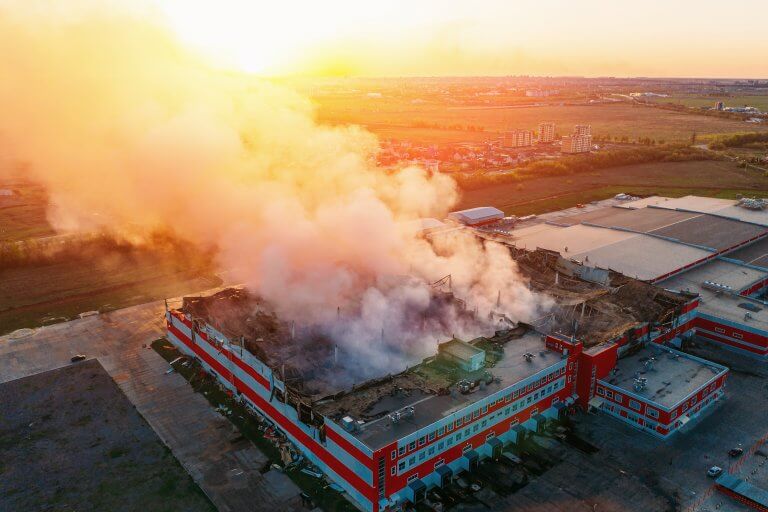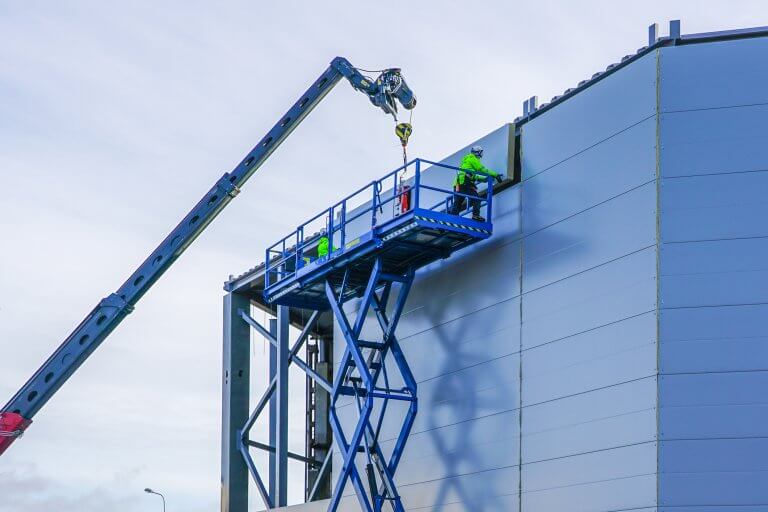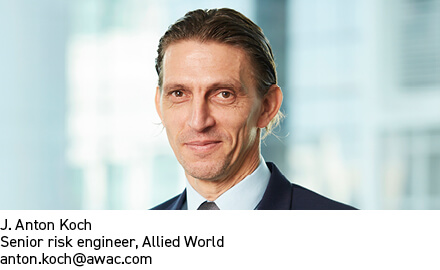Allied World: Combustible cladding – is it ever safe to use?
September 17 2020By J. Anton Koch, senior risk engineer, Allied World
When fire strikes in buildings using foam plastic materials, the results can be catastrophic – often resulting in the tragic loss of life and widespread damage to the property. The use of such materials is still commonplace throughout the world for a range of reasons. In order to keep people safe, you should always try and avoid using combustible cladding.
Why has cladding been widely used?
After the Second World War, the use of foam-plastic materials in industrial and residential buildings became widespread. Cheap and mass produced, foam plastics have great insulating characteristics and form the core material of cladding systems, which help improve the aesthetics of a building, as well as keeping ever-more large-scale buildings warm or cool.
As a result, foam-plastics became known as a low-cost, innovative and energy-efficient building material – perfect as an insulating material in wall cavities and underneath roof covers to keep buildings cool or warm.

Meanwhile, modern metal sheet constructions became commonplace, especially for industrial buildings, and these typically have metal sandwich panel walls and roofs. As buildings increased in size and height, customised cladding systems were increasingly used as an encasement of insulation material between metal sheets – the foam plastic layers being interrupted only by integrated window frames.
Dispelling the myth
All foam-plastics are combustible foam plastics are popular because they are high performing and light weight, however, the major downside of these materials is that they are always combustible. Even the so-called ‘fireretardant’ foams that are meant to slow down or stop the spread of fire or reduce its intensity are still a huge danger to people during a fire as they will emit higher amounts of toxic fumes such as hydrogen cyanide and carbon monoxide than other foams.
Competing insulating materials – which are non-organic and non-combustible – such as mineral wool, rockwool, or glasswool, are often not chosen as they tend to be more expensive, not as easy to install, and may even have inferior insulating characteristics. In hot climates, they may also have shorter lifespans. However, these non-combustible materials have the lowest toxic emission levels, and they are fundamentally safer. What happens to cladding in a fire?
When a fire occurs, the plastic foam will decompose within the panel or encasement system and ‘melt’. Not only does it mean that the fire spread is ‘invisible’ (inside the panel), but also the emitted vapours are in fact highly flammable themselves and highly toxic.
Things to remember when cladding is on fire:
- Initially ‘invisible’ fire within encasements.
- Toxic and flammable fumes endangering lives, hampering firefighting and leading to new fire and even explosions.
- Molten foam decomposed to oily droplets, endangering people, obstructing firefighting and again potentially leading to new fires.
- Once above a certain energy threshold, the fire may best be fought with foam-extinguishing media as foam-plastic is made from oil. In any case huge amounts of water are required to even cool down, not yet affected parts of the building and neighbouring buildings (which otherwise could catch fire even across the street owing to radiation heat).
- Above initial stages and critical threshold, the damage from the fire may very well destroy the building. Only large free spaces between buildings and possibly old-fashioned parapet fire break walls might stop fire spread.
The deadly legacy of foam plastic cladding
 There have been a number of high-profile fires resulting in widespread damage and a tragic loss of life. The 1953 fire at the General Motors building in Livonia, Michigan, was the largest industrial loss ever at the time. Some 32,000 employees were made unemployed, and the insurance loss was over US$800 million – which if calculated today, would amount to around US$7.4 billion.
There have been a number of high-profile fires resulting in widespread damage and a tragic loss of life. The 1953 fire at the General Motors building in Livonia, Michigan, was the largest industrial loss ever at the time. Some 32,000 employees were made unemployed, and the insurance loss was over US$800 million – which if calculated today, would amount to around US$7.4 billion.
In 2017, 72 people died when fire ripped through the Grenfell Towers high rise building in London, which had cladding containing a composite poly-isocyanate and poly-ethylene core.
As a result, many countries are re-appraising high-rise buildings and cladding and insulation systems, and many structures which had previously been deemed ‘safe’ may now be considered uninhabitable.
How the risk of cladding has increased
As global trade has increased and more people have moved into high-density, high-rise buildings, the risks associated with cladding has become larger and more complex and therefore much more difficult for stakeholders to accurately predict. The safer alternatives to foam-plastics.
When it comes to choosing an insulating material, building owners and decision-makers must balance costs and building functionality with safety and the need to protect both people and assets. Non-combustible mineral wool, rockwool or glasswool have the lowest toxic emission of deadly fumes. Given that most fire fatalities are the result of the inhalation of toxic fumes and asphyxiation, and not to burning, this adds another compelling reason to use these materials instead of foam-plastics.
Futureproof your building: avoid foam-plastic material altogether
Today, all stakeholders have a shared responsibility to safeguard against any potential loss of life and other catastrophic losses.
In addition to pure financial losses, considering non-insured losses, particularly life safety, should be front and centre of any decision. Protecting assets through insurance is only part of the equation when designing or building as property and insurance markets are under increasing pressure to decline insuring buildings which are constructed using combustible materials.

For more information about Allied World’s Risk Management services or our insurance and reinsurance solutions, please visit www.alliedworldinsurance.com
Anton Koch is a senior risk engineer with Allied World and is currently based in Singapore. Previously, Anton worked with two large global insurance carriers where he established their semiconductors specialty business groups. Anton has over 25 years of experience within the insurance industry, embedding risk management systems for Fortune 500 clientele. His silicon platform client list includes telecommunications manufacturers, LCD screen manufacturers and other leading electronics firms. Anton has lived and worked in Europe, Asia and the US.
At Allied World, we understand that preventing the loss of life will always come first. However, we are also committed to ensure minimum impact on assets. Therefore, we look at the challenges and solutions when faced with this dilemma to find the best options to minimise the risk. By putting risk perspectives at the heart of discussions when mapping, engineering and designing major infrastructure projects, businesses can ensure that both people inside their premises as the buildings/installations themselves, are protected from every conceivable fire scenario.
-
Allianz General | Allianz General combines innovative protection solutions while powering social good to lead Malaysian market
The insurer proactively addresses emerging risks and evolving customer protection needs while giving back to the community.
-
Sedgwick | Asia’s Energy Transformation – Balancing Growth, Risk and Renewables
Energy market presents unique risks, especially in a region which includes China and Japan as well as developing nations like Vietnam and the Philippines.
-
Beazley | Turbulent Waters: the maritime energy transition challenge
Businesses are facing a complex transition to non-carbon energy sources amid a push to achieve net-zero emissions for the marine sector by 2050.
-
Aon | Navigating shifts in the global and Asia insurance markets
Neelay Patel, Aon head of growth for Asia, says the market in Asia is at an ‘interesting stage of the cycle’.
